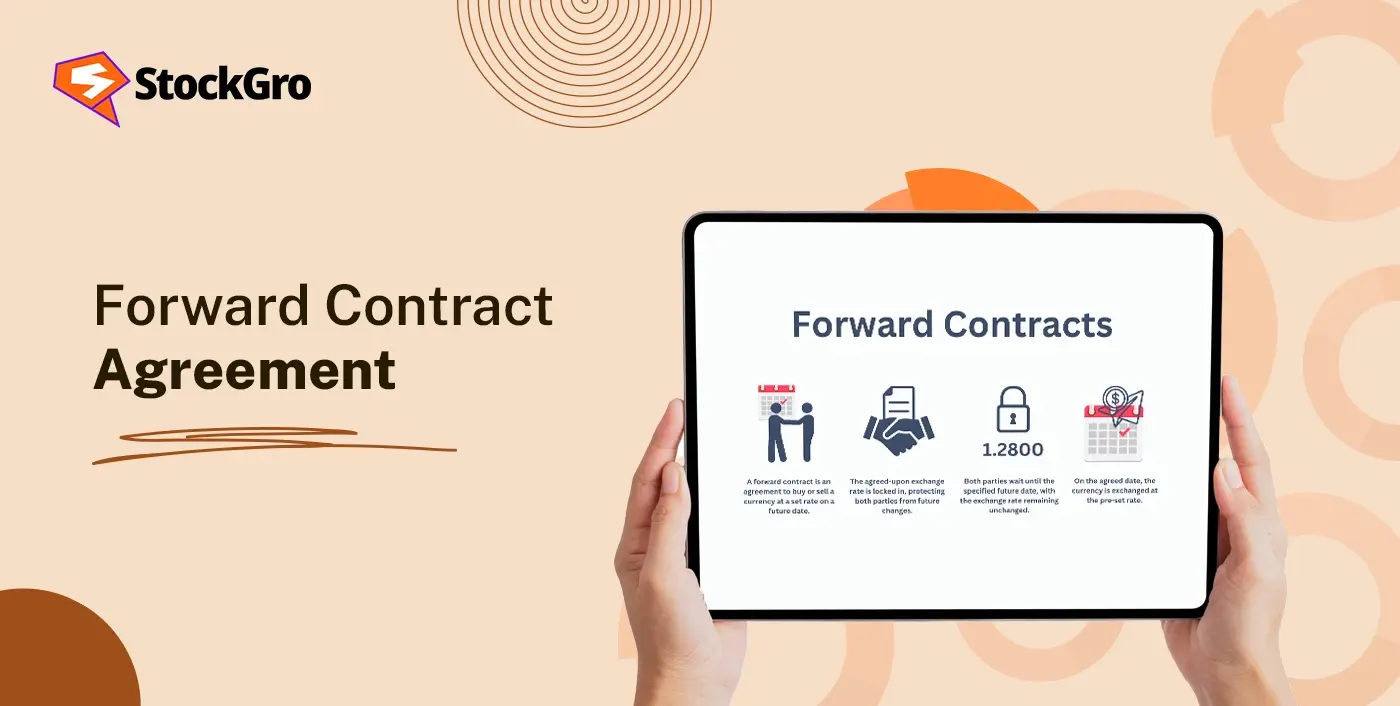
Every business faces uncertainty when tomorrow’s financial commitments seem clouded by shifting values in currency, commodities or credit. Such flux unsettles planning and complicates decisions. Some organisations choose to accept these swings, but many look for ways to reduce the impact.
One approach is the use of forward contract agreements, which allow future transactions to be arranged today on agreed terms. These instruments do not remove volatility, but they provide a measure of stability when markets move unpredictably. To understand their meaning, structure, types and the risks attached, the sections ahead offer a clear and practical overview.
What Is a Forward Contract Agreement?
It is a privately negotiated arrangement in which two counterparties consent to sale or purchase of an underlying asset at a pre-agreed value on a later date. Unlike standardised market instruments, this deal is over-the-counter or OTC, which allows full customisation regarding value, timing and terms of delivery. These instruments frequently appear in derivative trading in foreign exchange dealings, commodity trades & interest rate markets.
Enterprises use such contracts to mitigate unpredictability. For example, an importer can fix the cost of foreign receivables in advance to avoid future currency swings. This promotes stability in forecasting & protects profit margins.
How a Forward Contract Agreement Works
The mechanism begins when two entities consent to lock in terms that will be executed at a later point. Unlike standardised exchange-traded products, this contract remains private and customised by negotiation.
Key Elements of the Agreement:
- Asset: It denotes what is being exchanged, whether a currency, commodity or instrument
- Volume: This reflects the precise size of the commitment
- Price: It fixes the amount payable at maturity, independent of future swings
- Settlement date: It marks when obligations are discharged and the deal concludes
No payment is exchanged when the contract is signed. The entire payment is made at settlement, regardless of whether market conditions have shifted in favour of one side. Settlement may involve handing over the actual underlying or arranging a cash equivalent. Each side is bound by these terms, though an early exit can occur if both consent.
Forward Contract vs Futures & Options
These instruments belong to the family of derivatives whose worth stems from the underlying asset. A forward agreement is already understood as a contract arranged outside exchanges and settled on a specified future moment.
A future, by contrast, follows fixed rules, is traded through an exchange and recalibrated each day. An option departs further, conferring a right to act without imposing an obligation, which distinguishes it from the binding character of the other two.
| Feature | Forward | Futures | Options |
| Trading sphere | Privately negotiated in the OTC space | Conducted on formal exchanges with central oversight | Can be listed or arranged bilaterally depending on type |
| Structure | Fully customisable in price, size and date | Rigidly standardised in size, maturity and settlement rules | Built around a strike and expiry yet leaves choice to the buyer |
| Obligation | Both parties must complete the exchange on the agreed date | Enforceable commitments, but positions can be closed earlier | Purchaser retains the right, while the seller responds if called upon |
| Closure | Executed on the terminal date through delivery or monetary adjustment | Balanced daily under mark to market practice until expiry | Realised only when exercised otherwise lapses without consequence |
| Financial risk | High counterparty risk | Minimal risk as clearing house backstop every trade | Buyer’s loss capped at the premium while the seller carries greater liability |
Types of Forward Contract Agreements
Such OTC derivatives are designed in several formats, each responding to distinct commercial needs and market conditions. Their differences lie in timing, delivery practice and method of payment.
- Fixed price forward: The rate and maturity are determined in advance and remain unchanged throughout, commonly employed in commodity or currency trades.
- Open forward: The value is set when agreed, but the exact settlement moment remains unspecified, keeping the contract open until exercised.
- Window forward: The contract may be settled any time within a specified “window” or period rather than on a single date. This is helpful when the exact settlement date is uncertain but lies within a known timeframe
- Long-dated forward: Extends beyond twelve months, applied in longer-term planning scenarios where short contracts would be insufficient.
- Non-deliverable forward: Instead of tangible transfer, only the differential between contract price and prevailing spot price is settled in cash.
Use Cases & Examples
Forward contracts find application wherever uncertainty could distort financial outcomes. Different spheres reveal distinct patterns of how these instruments are employed.
- Agriculture and commodities: Farmers often fix crop prices before harvest to avoid revenue loss from declining markets. For instance, a farmer in India expects to harvest 1,000 quintals of wheat in six months. He entered a contract with a mill to sell the wheat at ₹2,200 per quintal in six months. The contract holds regardless of how the market changes, securing steady cash flow even if prices decline.
- Currency and foreign exchange: Businesses engaged in cross-border trade use forwards to guard against volatile exchange rates. For instance, a UK company importing machinery worth €1 million secures today’s pound–euro conversion, protecting itself from a weaker pound that would otherwise raise its expenses.
- Interest rate management: Borrowers enter into forwards to manage the risk of rising loan costs. A business expecting to take a loan in six months enters a forward rate agreement locking in today’s interest rate, protecting itself from potential rate hikes.
- Speculation: Some participants pursue gains rather than stability. An investor expecting the yen to strengthen enters a contract to obtain it at today’s parity, realising profit if appreciation materialises by maturity.
Pricing & Valuation Formula
Determining the forward value begins with the spot quotation of the underlying and then adjusts for factors such as interest charges or storage. At the outset the contract carries no gain for either side, yet as markets evolve one counterparty benefits while the other might record a loss.
Without dividends
F = S x e (r × t)
Where,
- F is the forward price
- S the spot price
- r the risk-free rate
- t the time to deliver (in years)
- e the mathematical constant 2.7183.
With carrying costs
F = S x e ((r + q) × t)
Here q captures additional charges like storage or insurance that arise while retaining the asset.
With dividends
F = (S – D) x e (r x t)
For assets with known dividend payments during the contract’s life, their present value D is subtracted from the spot price before compounding
Risks & Limitations
- Counterparty risk: Because transactions occur privately, performance depends entirely on the integrity of the other side. Failure to honour commitments at due date can cause significant disruption.
- Inflexible structure: Once conditions are agreed, revision is not possible. A sudden change in valuation may leave one side tied to unfavourable terms.
- Opportunity cost: By locking in a price today, parties lose the benefit of favourable movements in the price of the underlying asset. If the market moves in a beneficial direction, the party is still obligated to settle at the contract price, potentially missing out on profit
- Capital costs: Certain arrangements require margin or deposits that absorb working capital, increasing the expense of maintaining such positions.
Legal & Documentation Aspects
Laws
Forward agreements in India are primarily OTC agreements, making them non-standardised and privately negotiated. Their legal oversight depends on the asset class involved.
- Currency based forward contracts are governed by the RBI under the Foreign Exchange Management Act- FEMA. RBI regulations focus on hedging use, exposure reporting, and contract conditions such as cancellation and rebooking.
- Commodity forward contracts, once regulated by the Forward Markets Commission, came under the SEBI after FMC’s merger in 2015. SEBI now oversees commodity derivatives, including forward contracts, through the Securities Contracts (Regulation) Act, 1956. SEBI ensures transparency, fair practices and market integrity, even though these contracts remain OTC.
Documentation
Forwards exists outside organised exchanges which means their legal weight depends entirely on the clauses negotiated by the two sides. Right forward contract terms are critical because any ambiguity in wording may complicate enforcement should disagreements arise.
Most participants therefore insist on written records even though the law does not mandate a formal document. Electronic confirmations are also widely recognised, with digital acceptance carrying the same binding effect as paper contracts.
Margin deposits are often embedded to safeguard performance, with deposits recalibrated when exposure changes during the life of the contract. Early termination is rarely available, so those seeking to exit usually arrange an offsetting transaction that neutralises the first position.
Because there is no central clearinghouse, the documentation functions as the main protection for counterparties. Careful specification of obligations, delivery conditions and remedies for failure underpins the integrity of these bilateral dealings.
Best Practices & Negotiation Tips
- As noted above, define responsibilities with precision before finalising forward contract terms. Dates of delivery, scale of trade, pricing reference and guarantees should leave no room for ambiguity, as vagueness can later undermine enforceability.
- Maintain written or electronic confirmations as evidence. Formal documentation strengthens enforceability, while master agreements simplify management when multiple forwards are involved..
- Negotiate practical flexibility. Where possible, secure clauses that allow room in timing or collateral adjustments to accommodate evolving business conditions.
- Select counterparties wisely. Working with regulated and reputable institutions reduces legal uncertainty and provides recognised avenues for dispute resolution.
FAQ’s
It is a private arrangement where two sides agree on a price today for an exchange that will occur later. The terms are customised to their needs, covering value, quantity and timing. One party commits to buy while the other commits to sell. No transfer happens until the agreed date arrives. Such arrangements are often used to manage uncertainty in markets.
A company that imports goods may agree today on the rate at which its local currency will be exchanged when payment is due. This ensures costs remain known even if exchange values shift. Exporters do the same when expecting receipts from abroad. The approach helps stabilise revenue or expenses in volatile markets.
One is arranged privately between two sides and tailored to their needs. The other is traded on organised markets with fixed terms. Daily settlement applies in the exchange-traded version, while the private one settles only at the end. The first carries greater reliance on counterpart reliability. The second benefits from clearinghouse backing which reduces the risk of default.
Regulation differs by asset class. Currency forwards fall under the Reserve Bank of India through FEMA, with rules on hedging use and reporting requirements. Commodity forwards, previously supervised by the Forward Markets Commission, have been under SEBI since 2015 through the Securities Contracts Regulation Act. While SEBI and RBI provide oversight, these instruments remain OTC and privately negotiated, making their supervision less direct than exchange-traded products.
It represents the agreed value for a future exchange of an asset. The figure is linked to the current spot level and adjusted for factors like interest rates, storage or income from the asset. A standard formula – F = S x e (r × t) – uses spot price multiplied by the exponential of the risk-free rate over time. If the asset pays dividends, those expected payouts are deducted before applying the calculation. The result provides a fair level for settlement at maturity.
There are two common approaches at maturity. Physical delivery transfers the underlying asset. The buyer pays the agreed price. Cash settlement exchanges the difference between the contracted level and the market level. The chosen route is fixed in the terms, which usually mirrors commercial needs.
Several vulnerabilities can arise. One side may fail to honour its obligation. The terms stay locked even if markets move sharply. Settlement occurs only at maturity which can magnify losses. Liquidity is limited making it harder to exit early. Longer durations also increase the chance of default.
These agreements appear in several formats suited to different needs.
Fixed price forward sets both the rate and the settlement date in advance.
Open forward fixes the value but leaves the timing open until maturity.
Window forward allows settlement at any point within an agreed period.
Long dated forward extends beyond a year and is used for longer planning horizons.
Non deliverable forward (NDF) settles only the difference in cash without physical transfer of the underlying.

